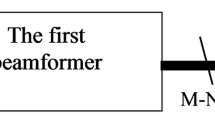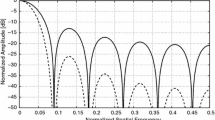Abstract
Aiming at the problem of high complexity and poor real-time performance of the traditional minimum variance (MV) algorithm, a low-complexity minimum variance algorithm combined with power method is proposed. Firstly, the echo data is transformed into beam domain by discrete cosine transform and the dimension reduction parameter is determined according to the data of scanning lines. Secondly, the maximum eigenvalue and corresponding eigenvector of sample covariance matrix are obtained by the power method to reduce the complexity of eigenvalue decomposition. Finally, by ignoring low-energy echo signal, the inversion of covariance matrix can be simplified to construct a new weighted vector, which can reduce the complexity of MV. The Field II simulation results show that the proposed algorithm has better resolution, contrast ratio and efficiency than the traditional MV algorithm, and outperforms the minimum variance algorithm based on eigenvalue decomposition (ESBMV) in resolution and efficiency.








Similar content being viewed by others
REFERENCES
L. V. De, G. Szekely, and C. Tanner, Ultrasound Med. Biol. 41 (12), 3044 (2018).
R. S. Bandaru, A. R. Sornes, J. Hermans, E. Samset, and J. D’hooge, IEEE Trans. Ultrason., Ferroelectr. Freq. Control 63 (12), 2057 (2016).
M. Sorensen, I. Domanov, and L. L. De, IEEE Trans. Signal Process. 66 (14), 3665 (2018).
A. Hassanien and S. A. Vorobyov, IEEE Signal Process. Lett. 16 (1), 22 (2009).
C. C. Zheng, J. Cheng, and H. Peng, Acta Acust. 42 (1), 109 (2017).
J. Kortbek, J. A. Jensen, and K. L. Gammelmark, Ultrasonics 53 (1), 1 (2013).
C. C. Shen, Y. Q. Xing, and G. Jeng, Ultrasonics 72 (1), 177 (2016).
C. C. Zheng, H. Peng, and Z. H. Han, Acta Phys. Sin. 63 (14), 413 (2014).
L. N. Ribeiro, A. L. F. de Almeida, and J. C. M. Mota, Signal Process. 158 (1), 15 (2019).
P. Wang, Y. Z. Shi, J. Y. Jiang, L. Kong, and Z. H. Gong, Acoust. Phys. 65 (1), 123 (2019).
T. Dietzen, A. Spriet, W. Tirry, S. Doclo, M. Moonen, and W. T. Van, IEEE/ACM Trans. Audio Speech Lang. Process. 27 (3), 544 (2019).
P. Wang, Z. H. Gong, N. Cheng, and N. Li, Acta Acust. 42 (2), 214 (2017).
I. K. Holfort, F. Gran, and J. Jeonsen, IEEE Trans. Ultrason., Ferroelectr. Freq. Control 56 (2), 314 (2009).
P. Wang, N. Cheng, Z. H. Gong, and L. H. Wang, Acta Phys. Sin. 64 (23), 404 (2015).
J. K. Li, X. D. Chen, Y. Wang, Y. F. Shi, and D. Y. Yu, Acoust. Phys. 63 (2), 229 (2017).
T. Su, S. Zhang, D. Y. Li, and D. J. Yao, Acoust. Phys. 64 (3), 379 (2018).
Q. Wang, B. Zhou, Y. Chen, and H. Quan, Acoust. Phys. 65 (2), 226 (2019).
D. R. Fuhrmann, IEEE Trans. Signal Process. 39 (10), 2194 (1991).
J. Park, S. M. Wi, and J. S. Lee, IEEE Trans. Ultrason., Ferroelectr. Freq. Control 63 (2), 256 (2016).
K. Kim, S. Park, J. Kim, S. B. Park, and M. Bae, IEEE Trans. Ultrason., Ferroelectr. Freq. Control 61 (6), 930 (2014).
J. Yang, E. Grunsky, and Q. M. Cheng, Nat. Resour. Res. 28 (2), 431 (2019).
R. C. de Lamare and R. Sampaio-Neto, IEEE Trans. Veh. Technol. 59 (3), 1217 (2010).
M. Albulayli and D. Rakhmatov, in Proc. 2013 IEEE Int. Conference on Acoustics, Speech, and Signal Processing (ICASSP) (Vancouver, 2013), p. 1061.
A. M. Deylami and B. M. Asl, Ultrasonics 66 (1), 43 (2016).
L. Candemir and I. Cilesiz, in Proc. 2008 Medical Imaging 2008: Physics of Medical Imaging(SPIE) (San Diego, CA, 2008), p. 6913.
K. Ranganathan and W. F. Walker, IEEE Trans. Ultrason., Ferroelectr. Freq. Control 54 (4), 782 (2007).
J. C. Tillett, J. P. Astheimer, and R. C. Waag, IEEE Trans. Ultrason., Ferroelectr. Freq. Control 57 (1), 214 (2010).
Funding
The work is funded by the National Key Research and the Development Program no. 2018YFB2100100, the NSFC Grant no. 51 677 010, Science and Technology Research Program of Chongqing Municipal Education Commission no. KJQN201803102 and Chongqing Natural Science Foundation no. cstc2018jcyjAX0032.
Author information
Authors and Affiliations
Corresponding author
Rights and permissions
About this article
Cite this article
Ping Wang, Du, T., Wang, L. et al. A Low-complexity Minimum Variance Algorithm Combined with Power Method for Ultrasound Imaging. Acoust. Phys. 66, 204–212 (2020). https://doi.org/10.1134/S1063771020020074
Received:
Revised:
Accepted:
Published:
Issue Date:
DOI: https://doi.org/10.1134/S1063771020020074




